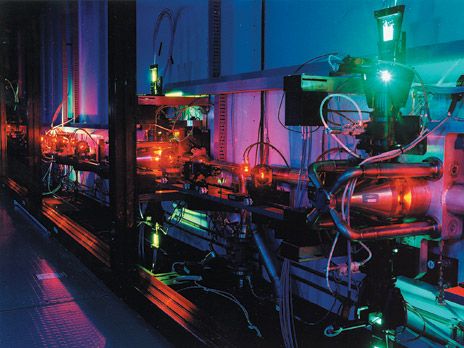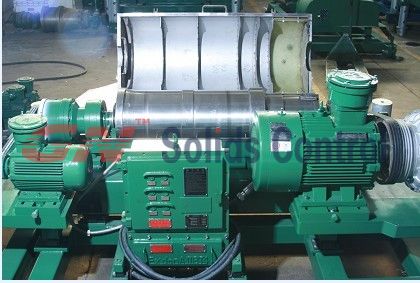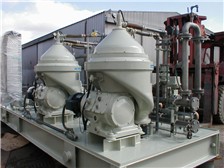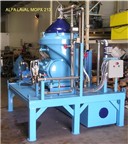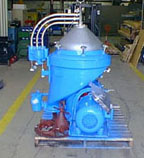The controversial technology poses proliferation risks, but nuclear firms press on
Two technology giants, GE and Hitachi, are betting big on a nuclear renaissance. The companies formed an alliance in 2007 to push for a global expansion of nuclear power. But selling new reactors is only half the game. The joint venture is also aggressively pursuing a controversial technique for making nuclear fuel using lasers, a method they hope to commercialize by building the world's first industrial-scale pilot plant in 2012. Regulatory agencies are worried that laser enrichment of uranium could lead to the proliferation of nuclear weapons.
GE has called the laser method a "game-changing technology" and along with Hitachi and Cameco Corp., a Canadian nuclear fuel provider in Saskatoon, Sask., is devoting hundreds of millions of dollars to developing it and building the plant near Wilmington, N.C. The technology in question was licensed from Silex Systems, an Australian company that's been quietly conducting enrichment research at a small facility near Sydney for the last quarter century.
But many experts are skeptical. Allan Krass, a retired U.S. State Department official and a physicist who visited Silex's laboratory in 2000, says GE and Hitachi "are betting that there will be an upsurge of nuclear power plant construction—that's a huge and extremely risky bet." He adds that laser enrichment has been held back by substantial technical hurdles.
If approved, the pilot plant will be the first large-scale attempt to use photons to separate the desirable uranium-235 isotopes from the more abundant but nonfissile U-238 isotopes found in natural uranium. Experts generally believe that a laser facility would be both smaller in size and have much lower energy demands than existing enrichment plants. Those features are excellent from the perspective of improving the economics of nuclear power plants, but they also present a major headache for the International Atomic Energy Agency (IAEA) and other nuclear watchdog groups attempting to spot clandestine enrichment plants, largely from satellite imagery.
At least 20 countries have attempted—and, at one point or another, failed—to use lasers to economically separate uranium isotopes since the 1970s. "Everyone was looking for this magical elixir, the best way to do this," recalls Dennis Garratt, who was director of R&D for Cameco from 1989 to 1996.
So what's different this time? And will this version of laser enrichment somehow be proliferation proof? When contacted by IEEE Spectrum, GE-Hitachi, Silex, and the IAEA wouldn't say. But some hints can be found in the technology's history.
Of the many government-sponsored laser enrichment programs, most were shut down in anticipation of a 1993 agreement between the United States and Russia, known as the Megatons to Megawatts Program, which flooded the market with cheap uranium scavenged from Russia's nuclear arsenal. The engineers and physicists working in those laboratories tend to argue that they were on the verge of success when their projects were discontinued.
In essence, all those programs made use of the unique frequencies at which atoms and molecules vibrate. A laser tuned to the precise vibrational frequency of a U-235 atom or a molecule containing U-235 can cause that isotope to behave differently from the heavier U-238.
Broadly, in the method that Silex explored, called molecular laser isotope separation, enrichment begins with uranium hexafluoride gas—in which each uranium atom is surrounded by six fluorine atoms—mixed with an inert gas that dilutes the uranium. The gas is cryogenically cooled and shot out of a nozzle at supersonic speeds. Rapid-fire pulses from an infrared laser penetrate the gas, increasing the vibrational energy in the U-235 molecules' chemical bonds.
That higher vibrational energy causes each U-235 molecule to react more quickly with a third substance in the gas stream, explains Garratt. In one version of the process, a new molecule forms around the U-235. The new molecule lasts for less than a microsecond before breaking apart, and the repelling force from that event pushes the U-235 to the edges of the stream, where it can then be siphoned off.
Though the precise mechanics of Silex's process may differ, the underlying logic is that illuminating a gas with a laser would require only a fraction of the energy needed by the two methods used now to enrich uranium—spinning the gas in a series of centrifuges or repeatedly forcing it through a porous membrane.
At least that's the theory. In practice, several obstacles have kept the technology in the lab. "These lasers are unlike any other in the world—basically, if you need a laser, you've got to go invent one," says Bruce Warner, a laser physicist who led Lawrence Livermore National Laboratory's enrichment program, in Livermore, Calif., until the program's demise in the late 1990s.
According to several laser enrichment experts, Silex's approach likely begins with a 10.8-micrometer carbon dioxide laser that pulses hundreds of times per second. The infrared pulses travel through elaborate optics that tune their wavelengths to the needed 16 µm. Each pulse must contain about one joule of energy and be repeated fast enough to expose as much gas as possible. And if the laser doesn't pulse fast enough? Add more lasers! In short order you can wind up with an expensive and complex assembly of staggered pulsing lasers, each with its own set of tuning optics.
source: spectrum.ieee.org








